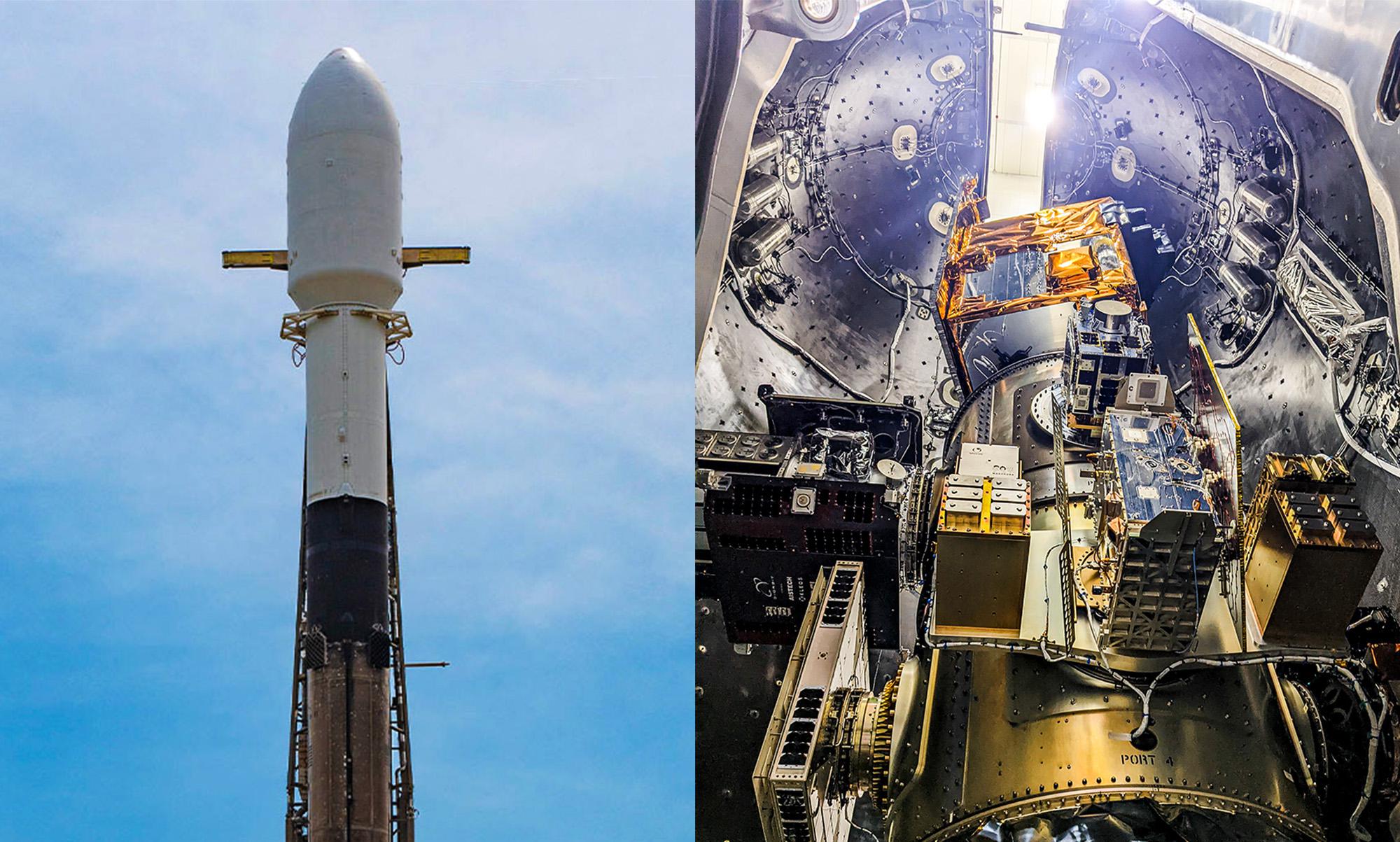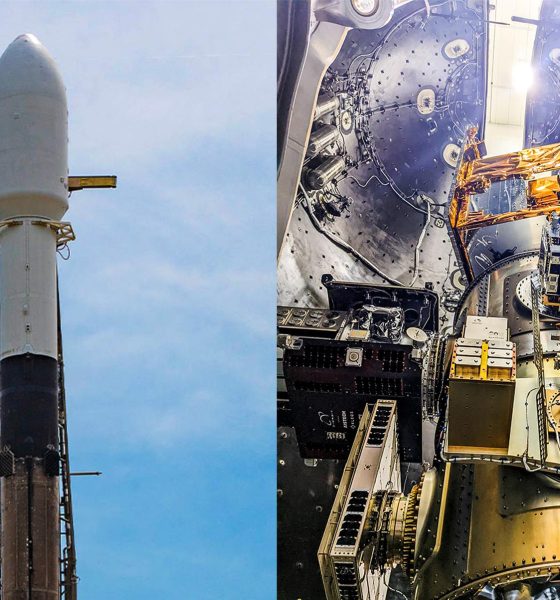

News
SpaceX set to launch 40 satellites on fourth dedicated rideshare mission
SpaceX says a Falcon 9 rocket is on track to launch its fourth dedicated rideshare mission no earlier than (NET) 12:24 pm EDT (16:24 UTC) on Friday, April 1st.
Known as Transporter-4, SpaceX will launch the batch of 40 customer satellites out of its Cape Canaveral Space Force Station (CCSFS) LC-40 pad. Poor weather means that the company currently has a roughly 30% chance of favorable conditions on April 1st, improving to 50% on April 2nd and 80% on April 4th. Following the first NASA Space Launch System (SLS) rocket’s trip to a nearby launch pad, SpaceX also has to work around the agency’s plans to attempt an important wet dress rehearsal (WDR) test as early as April 3rd, preventing any launches that day.
SLS has already partially contributed to delays to Axiom-1 – the first all-private astronaut launch to the International Space Station – and could potentially disrupt Transporter-4 if weather or Falcon 9 fail to cooperate on Friday or Saturday.
Transporter-4’s payload of 40 satellites is the smallest number SpaceX has ever manifested on one of its dedicated rideshare missions. It’s unclear why so few satellites will be aboard, but one customer in particular likely explains why the company can launch such a small payload. That customer is Germany’s national space agency (DLR), which has manifested EnMAP – a hyperspectral Earth observation satellite – on Transporter-4. EnMAP itself is quite a bizarre case: the wildly overambitious smallsat was initially scheduled to launch as early as 2012 but has suffered a full decade of delays as endless issues arose. Painfully, those delays mean that EnMAP – a spacecraft largely designed before 2010 – is merely the latest in a long line of similarly capable satellites. Italy, for example, began work on an almost identically capable spacecraft – PRISMA – in 2008 and launched it in 2019 for ~$140 million.
According to one estimate, EnMAP’s cost has likely ballooned from ~$100 million to more than $330 million. In other words, it’s fairly reasonable to assume that SpaceX was able to charge DLR quite a bit more than Transporter-4’s other rideshare customers. SpaceX could have positioned it as a heavily discounted dedicated launch that just so happens to carry some secondary payloads – perhaps charging ‘just’ $15-30 million. EnMAP (950 kg or 2100 lb) is slightly heavier than the maximum weight SpaceX’s one-size-fits-all pricing allows for, but a customer with a similar 830 kilogram (1830 lb) spacecraft could launch it for as little as $4.6 million on a Transporter mission.
Of Transporter-4’s 40 payloads, at least 16 are using intermediaries like Spaceflight, Exolaunch, and D-Orbit, who then deal with SpaceX for the satellite owners. Excluding EnMAP, at least six other customers likely booked directly through SpaceX. Combined, total Transporter-4 revenue before EnMAP could be as low as ~$13 million. According to a SpaceX executive speaking in 2020, the total cost of a Falcon 9 launch with a recoverable, flight-proven booster is $28 million. Given that some executives have compared Transporter missions to public transit, it’s possible that SpaceX is willing to launch some rideshare missions even knowing they will lose money, but it’s hard to imagine it would burn $10-15 million (or more) instead of just delaying a few months to add more payloads.
Even though EnMAP is thus likely picking up all of financial slack, Transporter-4 is still a good demonstration of SpaceX’s flexibility – flexibility that current or prospective providers with much smaller rockets simply can’t match. With Falcon 9, SpaceX can just throw a 1-ton, $300 million spacecraft on top of a several-dozen-satellite rideshare mission and still recover both the booster and fairing without issue – all while charging its smaller customers a more or less unbeatable $1.1 million per 200-kilogram slot and $5500 for each additional kilogram.
SpaceX will begin streaming its first Transporter-4 launch attempt around 12:10 pm EDT (16:10 UTC).

News
Tesla FSD fleet is nearing 7 billion total miles, including 2.5 billion city miles
As can be seen on Tesla’s official FSD webpage, vehicles equipped with the system have now navigated over 6.99 billion miles.

Tesla’s Full Self-Driving (Supervised) fleet is closing in on almost 7 billion total miles driven, as per data posted by the company on its official FSD webpage.
These figures hint at the massive scale of data fueling Tesla’s rapid FSD improvements, which have been quite notable as of late.
FSD mileage milestones
As can be seen on Tesla’s official FSD webpage, vehicles equipped with the system have now navigated over 6.99 billion miles. Tesla owner and avid FSD tester Whole Mars Catalog also shared a screenshot indicating that from the nearly 7 billion miles traveled by the FSD fleet, more than 2.5 billion miles were driven inside cities.
City miles are particularly valuable for complex urban scenarios like unprotected turns, pedestrian interactions, and traffic lights. This is also the difference-maker for FSD, as only complex solutions, such as Waymo’s self-driving taxis, operate similarly on inner-city streets. And even then, incidents such as the San Francisco blackouts have proven challenging for sensor-rich vehicles like Waymos.
Tesla’s data edge
Tesla has a number of advantages in the autonomous vehicle sector, one of which is the size of its fleet and the number of vehicles training FSD on real-world roads. Tesla’s nearly 7 billion FSD miles then allow the company to roll out updates that make its vehicles behave like they are being driven by experienced drivers, even if they are operating on their own.
So notable are Tesla’s improvements to FSD that NVIDIA Director of Robotics Jim Fan, after experiencing FSD v14, noted that the system is the first AI that passes what he described as a “Physical Turing Test.”
“Despite knowing exactly how robot learning works, I still find it magical watching the steering wheel turn by itself. First it feels surreal, next it becomes routine. Then, like the smartphone, taking it away actively hurts. This is how humanity gets rewired and glued to god-like technologies,” Fan wrote in a post on X.
News
Tesla starts showing how FSD will change lives in Europe
Local officials tested the system on narrow country roads and were impressed by FSD’s smooth, human-like driving, with some calling the service a game-changer for everyday life in areas that are far from urban centers.

Tesla has launched Europe’s first public shuttle service using Full Self-Driving (Supervised) in the rural Eifelkreis Bitburg-Prüm region of Germany, demonstrating how the technology can restore independence and mobility for people who struggle with limited transport options.
Local officials tested the system on narrow country roads and were impressed by FSD’s smooth, human-like driving, with some calling the service a game-changer for everyday life in areas that are far from urban centers.
Officials see real impact on rural residents
Arzfeld Mayor Johannes Kuhl and District Administrator Andreas Kruppert personally tested the Tesla shuttle service. This allowed them to see just how well FSD navigated winding lanes and rural roads confidently. Kruppert said, “Autonomous driving sounds like science fiction to many, but we simply see here that it works totally well in rural regions too.” Kuhl, for his part, also noted that FSD “feels like a very experienced driver.”
The pilot complements the area’s “Citizen Bus” program, which provides on-demand rides for elderly residents who can no longer drive themselves. Tesla Europe shared a video of a demonstration of the service, highlighting how FSD gives people their freedom back, even in places where public transport is not as prevalent.
What the Ministry for Economic Affairs and Transport says
Rhineland-Palatinate’s Minister Daniela Schmitt supported the project, praising the collaboration that made this “first of its kind in Europe” possible. As per the ministry, the rural rollout for the service shows FSD’s potential beyond major cities, and it delivers tangible benefits like grocery runs, doctor visits, and social connections for isolated residents.
“Reliable and flexible mobility is especially vital in rural areas. With the launch of a shuttle service using self-driving vehicles (FSD supervised) by Tesla in the Eifelkreis Bitburg-Prüm, an innovative pilot project is now getting underway that complements local community bus services. It is the first project of its kind in Europe.
“The result is a real gain for rural mobility: greater accessibility, more flexibility and tangible benefits for everyday life. A strong signal for innovation, cooperation and future-oriented mobility beyond urban centers,” the ministry wrote in a LinkedIn post.
News
Tesla China quietly posts Robotaxi-related job listing
Tesla China is currently seeking a Low Voltage Electrical Engineer to work on circuit board design for the company’s autonomous vehicles.

Tesla has posted a new job listing in Shanghai explicitly tied to its Robotaxi program, fueling speculation that the company is preparing to launch its dedicated autonomous ride-hailing service in China.
As noted in the listing, Tesla China is currently seeking a Low Voltage Electrical Engineer to work on circuit board design for the company’s autonomous vehicles.
Robotaxi-specific role
The listing, which was shared on social media platform X by industry watcher @tslaming, suggested that Tesla China is looking to fill the role urgently. The job listing itself specifically mentions that the person hired for the role will be working on the Low Voltage Hardware team, which would design the circuit boards that would serve as the nervous system of the Robotaxi.
Key tasks for the role, as indicated in the job listing, include collaboration with PCB layout, firmware, mechanical, program management, and validation teams, among other responsibilities. The role is based in Shanghai.
China Robotaxi launch
China represents a massive potential market for robotaxis, with its dense urban centers and supportive policies in select cities. Tesla has limited permission to roll out FSD in the country, though despite this, its vehicles have been hailed as among the best in the market when it comes to autonomous features. So far, at least, it appears that China supports Tesla’s FSD and Robotaxi rollout.
This was hinted at in November, when Tesla brought the Cybercab to the 8th China International Import Expo (CIIE) in Shanghai, marking the first time that the autonomous two-seater was brought to the Asia-Pacific region. The vehicle, despite not having a release date in China, received a significant amount of interest among the event’s attendees.








